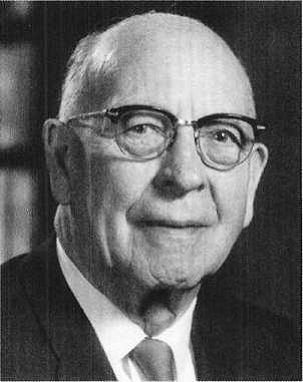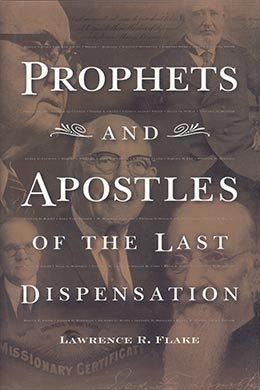LeGrand Richards
Lawrence R. Flake, Prophets and Apostles of the Last Dispensation (Provo, UT: Religious Studies Center, Brigham Young University, 2001), 489–91.

Born: 6 February 1886, Farmington, Utah
Presiding bishop of the Church: 6 April 1938
Quorum of the Twelve Apostles: 10 April 1952 (age 66)
Died: 11 January 1983 (age 96), Salt Lake City, Utah
As a boy, LeGrand Richards worked many hours cutting hay with his father, George F. Richards, on their dry farm in Tooele, Utah. Since there was no shade anywhere about, at noon they would drop the tines of their hay rake, cover them with hay and sit underneath this makeshift canopy to eat their lunch. One summer LeGrand’s cousin from Salt Lake City, Stephen L Richards, visited the farm and joined LeGrand and his father in their labor. Later Elder LeGrand Richards made this observation: “It was rather unique that under that hay rake on that dry farm one summer were three future apostles of the Church, though not one of us knew at the time. [1] LeGrand also had the distinction of being the third in a direct line of apostles, for his grandfather, Franklin D. Richards, also served in the Quorum of the Twelve.
In January 1902 LeGrand, then only sixteen years old, left the farm, boarded with his brother in Salt Lake City, and attended Salt Lake Business College, where he studied English and mathematics under J. Reuben Clark Jr. and attended Elder James E. Talmage’s Sunday School class.
Although the young man had secured a good job and had been promoted to a better one, he willingly gave it up in 1905 to accept a mission call to the Netherlands. Of this time in his life he wrote: “I had such wonderful experiences that at times it almost seemed that I walked and talked with the Lord.” [2] Returning home in 1908, he met Ina Jane Ashton, a young school teacher who was boarding with his parents in Tooele. After securing employment in Oregon as secretary of the Portland Cement Company, he married Ina Jane in the Salt Lake Temple. They lived in Oregon a short time but returned to Salt Lake City, where they desired to raise their children, who eventually numbered eight. Here Elder Richards developed a prosperous real estate business, which he willingly interrupted time and again to accept numerous calls to serve the Lord.
In 1914, at the age of only twenty-seven, LeGrand returned to his former mission field in Holland as mission president. In 1926 he served a short mission to the eastern states, and in 1931 he was called by President Heber J. Grant to sell his real estate business and move to California so he could serve as president of the Hollywood Stake. After three years in California, he again accepted a call as a mission president—this time to the southern states. Only one year after returning to Salt Lake City, while serving as bishop of the University Ward, Elder Richards received a call to become presiding bishop of the Church. In1952, after fourteen years in that office, he was called to the Quorum of the Twelve, where he would render outstanding service for more than three decades.
Elder Richards became well known throughout the Church as the author of A Marvelous Work and a Wonder, a book he wrote and published as a missionary tool without accepting monetary renumeration from its sale. [3] It has sold over three million copies and has been a great influence in teaching people the gospel. His unbounded energy despite advancing years caused many who knew him to refer to Elder Richards himself as “a marvelous work and wonder.” A long-time interest in and feeling of kinship for the Jewish people prompted him to write another book, Israel, Do You Know?
Elder Richards, a faithful apostle of the Lord, warmed the hearts of thousands with his delightful speaking style as he spoke throughout the Church, telling many fascinating personal, faith-promoting stories. When he died 11 January 1983 he had lived longer than any general authority in this dispensation—one month short of ninety-seven years. At his funeral, President Gordon B. Hinckley observed, “I have often felt . . . that [Elder Richards’] parents were inspired when they named him LeGrand. The Le is the French equivalent of the article the in our language. Grand is just what it means in our language. The synonyms for that word are magnificent, imposing, stately, majestic, impressive, wonderful.” [4]
Notes
[1] LeGrand Richards, Just to Illustrate (Salt Lake City: Bookcraft, 1961), 12.
[2] “LeGrand Richards,” Improvement Era, November 1966, 1002.
[3] Lucile C. Tate, LeGrand Richards: Beloved Apostle (Salt Lake City: Bookcraft, 1982), 255.
[4] “Elder LeGrand Richards is Eulogized,” Ensign, March 1983, 76.
